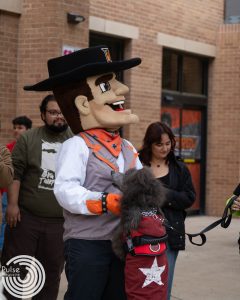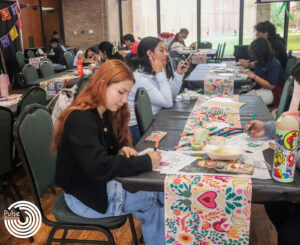“Un retrato”
Timeless and meaningful photographs are what Verónica Gabriela Cárdenas, a documentary photographer based in the Rio Grande Valley, Texas, hopes to capture with her project “Un retrato.”
The project, viewable since January 2016 at veronicagabriela.com, showcases images of people in the isolated village of Santa María Alotepec, Oaxaca, México holding prints of their portraits. Some of the people photographed do not remember the last time they had their photo taken, while others know they haven’t had their picture taken in decades. A man, for example, remembers his last portrait being taken more than 30 years ago. A couple who has been together for more than 50 years got their first photo taken by Cárdenas as well.
Cárdenas’ interest in photographing the people of Alotepec began with her first visit to the town. In June 2013, Efraín Martínez, a friend of Cárdenas’ and hostel-owner in Oaxaca, invited her to Alotepec. He showed her around the village of Alotepec–one of the poorest towns in the region.
“She wanted to learn more about the cultures of Oaxaca and take pictures of people,” Martínez said. “I told her that I was working at the same time in communities in the Mixe hills helping chilli and coffee farmers find commercial opportunities in Oaxaca and other regions of Mexico. So, we decided to go together to visit the chilli farm and get an overview of how the real rural life is.”
After getting a first-hand inside look at the culture in Alotepec, the photographer got an itch to keep returning to the town to take more photographs.
On a different occasion, in August 2014, Cárdenas attended a bull-killing event–a special festive sacrifice intended to feed the townspeople of Alotepec–which she decided to document .
While walking back to her friend’s house from the bull-killing sacrifice, a woman by the name of Floriana approached her and asked to get photographed, unknowingly setting off the project “Un retrato.”
“She saw me with a camera and she asked me, ‘Can you take a picture of me with my grandpa? My grandma passed away two years ago and I never took a picture with her,’” Cárdenas said. “And of course I said yes. So we met up the next day and I went up to the grandpa’s house–everything within walking distance, it’s a small village–and when she showed me the photos of her grandma, they had been taken at least 15 years ago.”
Cárdenas was so moved by the experience with Floriana that she decided to print copies of the photographs she took and gave them to her friend to deliver to the woman.
“I went back in November and I went to ask if [Floriana] had received the photos,” the Monterrey native said. “So she showed me the photo and I don’t know why my first instinct was to take a picture of her holding the photo. I guess it’s kind of a way to document that she had received the photo.”
After photographing Floriana and her family, Cárdenas took photos of more town inhabitants at random as she explored the village.
To make it easier for the townspeople to receive their photos, Cárdenas bought a portable printer that prints 4-by-6 photos, making it possible to distribute photos the same day they were taken or the following.
Cárdenas has been able to deliver photos to about 40 families within the four times she has visited Alotepec. She usually takes a wide shot and close-up of each individual and gives them two copies of each photo to give to their relatives. Others also choose to take family portraits.
Due to the language barrier between Cárdenas and the people of Alotepec, little feedback beyond facial gestures and smiles is exchanged with the photographer.
“I took some photos of them looking at their photo and some, they don’t say much, but they just stare at it,” Cárdenas said. “I’ve asked them ‘How meaningful is this photo to you?’ And [according to the translator] they say that they’re glad they have a photo now because they can pass it on to their grandkids.”
Although some of the people of Alotepec have lived without photos for years, Cárdenas feels that she is bringing a good experience and service to the town.
“I feel good that I can bring a photo to their family–a way they can remember them,” the 31-year-old said. “People do look for me sometimes, if they see me they already know that I take pictures, so obviously it is something good.”
VERSATILITY
Cárdenas first picked up a camera when she was 7 years old. Her aunt asked her to take some family photos and noticed that for her young age, she took well-centered photographs using a film camera, unlike her 17-year-old cousin. However, Cárdenas didn’t pursue the hobby until she was 24 years old, when she discovered nature photography and started taking pictures of birds, butterflies and flowers.
After gaining an interest in photographing people, Cárdenas began taking pictures of people on the streets of South-Central Mexico on trips that her aunts from Monterrey would organize.
“I noticed that what also attracted me was the everyday moments in people’s lives,” the documentary photographer said. “Like my family or just taking photos of somebody drinking coffee. It was more people that started interesting me, rather than birds.”
Cárdenas began collecting works of street photography in 2011 with her small point-and-shoot Canon Powershot S95. She would take pictures of random people on the streets, sometimes following them around for a couple blocks, hoping to remain unnoticed, just to snap a photograph at the right moment. The adrenaline rush fed her passion for street photography and she liked using photographing tricks used by the pros such as her role model Eric Kim, a street photographer and photography educator currently based in Berkeley, California.
“I’ll pretend I’m taking a picture of a building, being all touristy, and then I pretend I’m looking at the picture I took, but I [actually] want to take a photo of the person in front of me,” Cárdenas said. “And then I take the picture and the person’s looking directly at the camera–and they think that I’m just looking at the picture I just took.”
IMPACTFULNESS
The experience Cárdenas has had as a photographer has carved new pathways for her.
“Eventually, I want to pursue a career in documentary photography full time,” Cárdenas said. “I think now it’s about time to put my work out there and see who can see it. I’m working and brainstorming about other projects over there as well.”
Cárdenas’ family is proud of her achievements and encourages her to continue to follow her dreams.
“Me siento muy orgullosa de ella,” Aunt Bertha Cárdenas said. “Yo como tía, que la vi desde niña y vi cómo se entusiasmaba con las cosas y con los instrumentos [musicales] y todo, siento que ella ahorita, eso es lo que ella [en realidad] quería, la fotografía.”
Translation: “I feel so proud of her,” Aunt Bertha Cárdenas said. “As an aunt, seeing her as a child and how she was enthusiastic about things and [musical] instruments and everything, I feel that now, this is what she truly wanted–to take photographs.”
Likewise, her friends are appreciative of her work.
Ricardo Antonio Monterrubio, a friend that helped deliver photos to Alotepec natives, believes in her future goals.
“Yo quisiera que ella continuara más que nada con este proyecto,” Monterrubio said.
Translation: “I would like more than anything for her to continue with this project,” Monterrubio said.
A former cycling friend was equally fascinated by the photographer’s photos.
“I have no idea how she’s able to add so much–it’s such vivid connection with just an ordinary moment,” Marissa Dávila said. “This is truly an artist who is thinking about this project on so many levels. This isn’t just somebody snapping photos. This is somebody taking the time to honor the moment. Taking the time to honor the process. And really being careful with it.”
Although the photographer prides herself in her work, one of the most meaningful moments during her time in Alotepec was one that she didn’t document with a lens.
On an evening with a lot of work ahead, Cárdenas took a break to play with some children in the streets. She had her camera, phone and backpack with more pictures to deliver, but she chose to live in the moment. Cárdenas remembers this time as one of liberation.
“It got to the point where we were running around and I said, ‘I better stop taking photos and just throw everything aside and just be free and enjoy this moment,’” Cárdenas said. “That moment was very meaningful to me, but I don’t really have photos.”
Now the children recognize her every time she visits Alotepec.
“Those are priceless moments,” Cárdenas said. “Those are the moments I enjoy the most–even more than taking the photos. It’s not about taking the photos, but more how people welcome you after you have taken their photos.”






